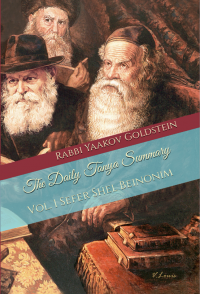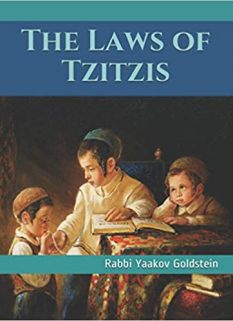*The article below is an excerpt from the above Sefer
*As an Amazon Associate I earn from qualifying purchases.
(LY) 28th Kisleiv
3. How to arouse the emotion of fear of G-d using Intellectual contemplation [i.e. Chabad]:
- When the intellect in the rational soul deeply contemplates and immerses itself exceedingly in the greatness of G-d he is able to arouse a fear of G-d. This is mainly accomplished through contemplating the following three matters relating to G-d:
- Mimalei Kol Almin: Contemplating how He fills all worlds.
- Soveiv Kol Almin: Contemplating how He encompasses all worlds
- Kula Kamei Kelo Chashiv: Contemplating how in His presence all creation is considered as naught before Him.
- The awe and fear created: Upon contemplating and immersing oneself in any of the abovementioned aspects of G-d’s greatness, the emotion of awe wonder and amazement, will be born and aroused in one’s mind and thought, to fear and be humble before the greatness of G-d, which is without end or limit, and a trepidation of G-d will also be born in his heart.
4. Arousing love of G-d from the above contemplation:
- Next, his contemplation of the above matters will give birth to an intense love, passion, longing and yearning for G-d, likened to a fiery flame, to the point of expiry of the soul, known as Klos Hanefesh.
5. The elements and bodily location from which the intellectual and emotional traits for G-d derive from:
- Yesod Haeish-The source of the love: This thirsting and passionate love for G-d derives from the element of fire that is found in the G-dly soul.
- Love is in the heart: This element of fire is housed in the heart, [and hence although it derives from the intellectual and G-dly soul which is in the brain, nonetheless, this emotion of love for G-d comes from the heart].
- Intellect is in the brain-Yesod Hamayim: The intellectual powers of the soul derive from the element of water that is found in the G-dly soul. This element of water is housed in the brain.
- The remaining emotions: The remaining emotions [i.e. Tiferes, Netzach, Hod, Yesod] are all considered a branch of fear and love for G-d, as will be elaborated on elsewhere.
The attribute of Daas:
- Scriptural terminology: The term Daas in Scripture is used in reference to marital unity between a husband and wife as stated in the verse that Adam knew his wife, Eve.
- A deep bond and connection to the intellectual concept: Accordingly, we can deduce that the term Daas refers to a deep bond and connection of the intellect. Thus, when a person deeply and intensely and persistently attaches his mind to the contemplation brought above regarding G-d’s greatness and does not remove his mind from it, then he is exercising his attribute of Daas.
- No Daas-No true feelings: It is specifically this intellectual attribute of Daas which has the capability of arousing the emotional traits of the G-dly soul of love and fear for G-d, as even if one contains much knowledge of G-d’s greatness if he does not deeply attach and anchor his mind on the contemplation of G-d’s greatness then no true emotion of fear and love will be aroused as a result of his even broad knowledge on the subject. Rather, mere imaginative emotions will be aroused.
- Thus, it is found that the attribute of Daas is the foundation of the emotions and is what gives it its energy and power.
- Daas incorporates all the emotions: Daas incorporates within it the attributes of Chesed and Gevurah, which includes the emotions of love and fear and all of their branches.
Related Articles
Daily Tanya Thursday 16th Sivan Shaar Hayichud Viemuna Chapter 6: Also Sheim Elokim is Chesed
Post Views: 14 Chapter 6: Also Sheim Elokim is Chesed 1. The Role of the Name Elokim The Name Elokim represents gevurah (severity) and tzimtzum (constriction). It conceals the supernal light that sustains creation, making the world appear self-sufficient and governed by natural law. Hence, its Gematria is “Hateva” which
Daily Tanya Wednesday 15th Sivan Shaar Hayichud Viemuna Chapter 5: The Attributes of Chesed and Gevurah in creation
Post Views: 56 Chapter 5: The Attributes of Chesed and Gevurah in creation 1. The Process of Tzimtzum and Creation Tzimtzum, the Divine contraction, enables creation by allowing created beings to perceive themselves as independently existing. Initially, the world was conceived to be created through stern judgment (gevurah), but the
Daily Tanya Tuesday 14th Sivan Shaar Hayichud Viemuna Chapter 4 Part 3: The Role of Kelim and Or
Post Views: 71 1. The Role of Kelim and Or The act of Tzimtzum and concealment is represented by the concept of kelim (vessels), which obscure the Divine life-force (or, meaning “light”). The kelim ensure that created beings cannot perceive the G-dliness inherent within them. 2. Letters and Divine Utterances
Daily Tanya Monday 13th Sivan Shaar Hayichud Viemuna Chapter 4 Part 2: Hashem’s Gevura is not comprehensible
Post Views: 70 13th Sivan 1. The Attribute of Chesed (“Hagadol”) The term “Hagadol” signifies G-d’s infinite kindness, which spreads life-force universally to all worlds and beings, regardless of merit. Chesed embodies the ability to create ex nihilo (creation out of nothing), a capacity unique to G-d. No created being
Daily Tanya Sunday 12th Sivan Shaar Hayichud Viemuna Chapter 4 Part 1: The Shield and the Sun: A Divine Analogy
Post Views: 101 Chapter 4: The Shield and the Sun: A Divine Analogy 12th Sivan 1. The Shield as a Protector The Divine analogy compares the sun’s shield to the Name Elokim, which conceals the Name Havayah. Just as the sun’s shield allows creatures to benefit from its rays without
Daily Tanya Shabbos 11th Sivan Shaar Hayichud Viemuna Chapter 3 Part 2: Illustration of Divine creation Through the Sun’s Light
Post Views: 71 1. Illustration Through the Sun’s Light The light shining from the sun serves as an apt metaphor for the Divine life-force. Within the sun itself, this light is inseparable from its source and thus considered non-existent in its own right. However, as the light radiates outward and


 Donate
Donate
Leave A Comment?
You must be logged in to post a comment.